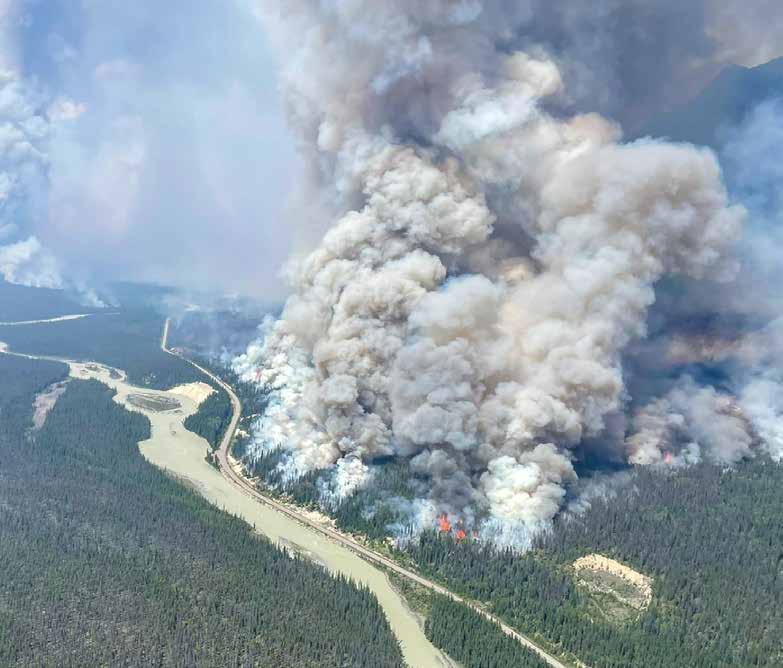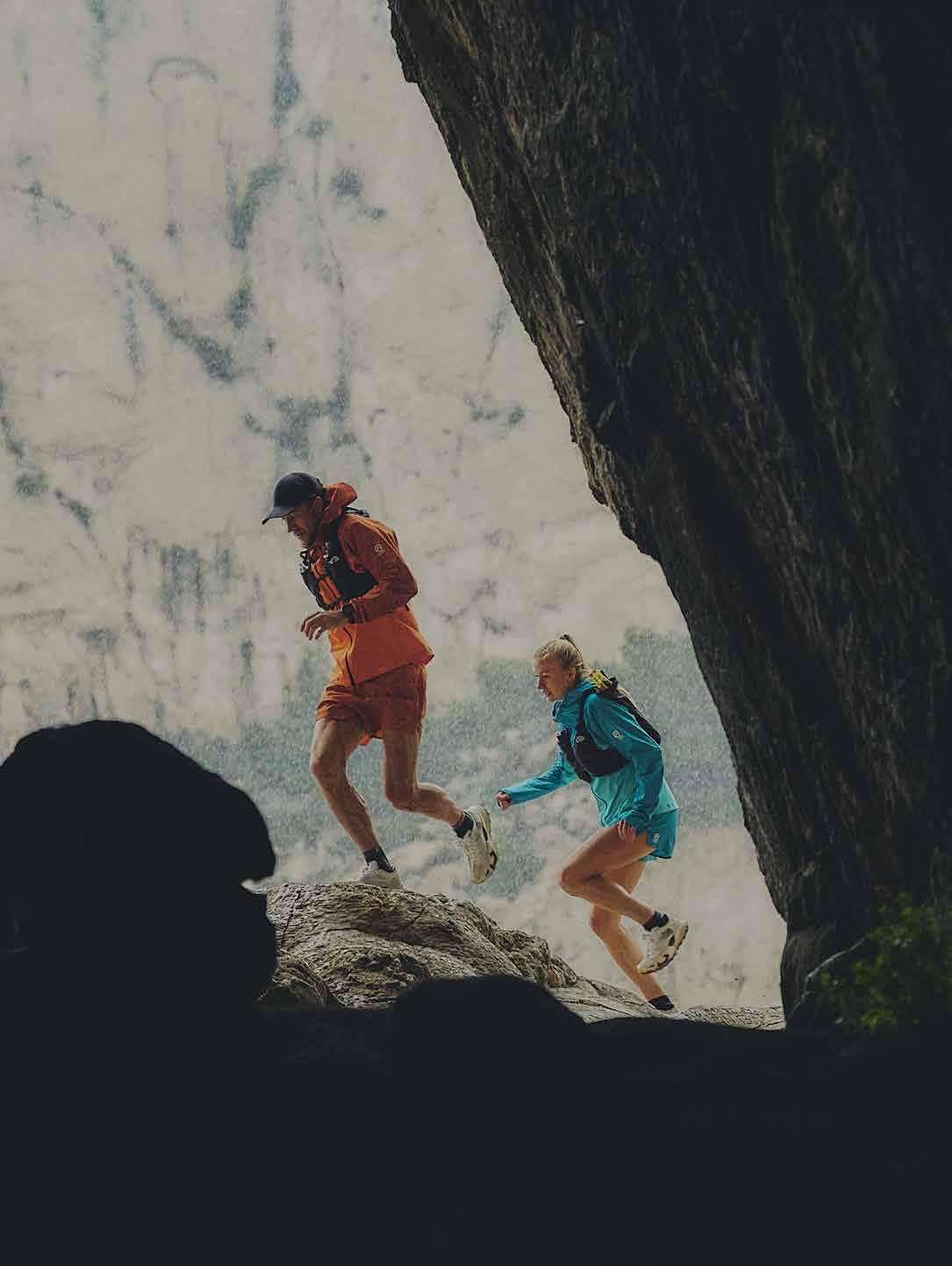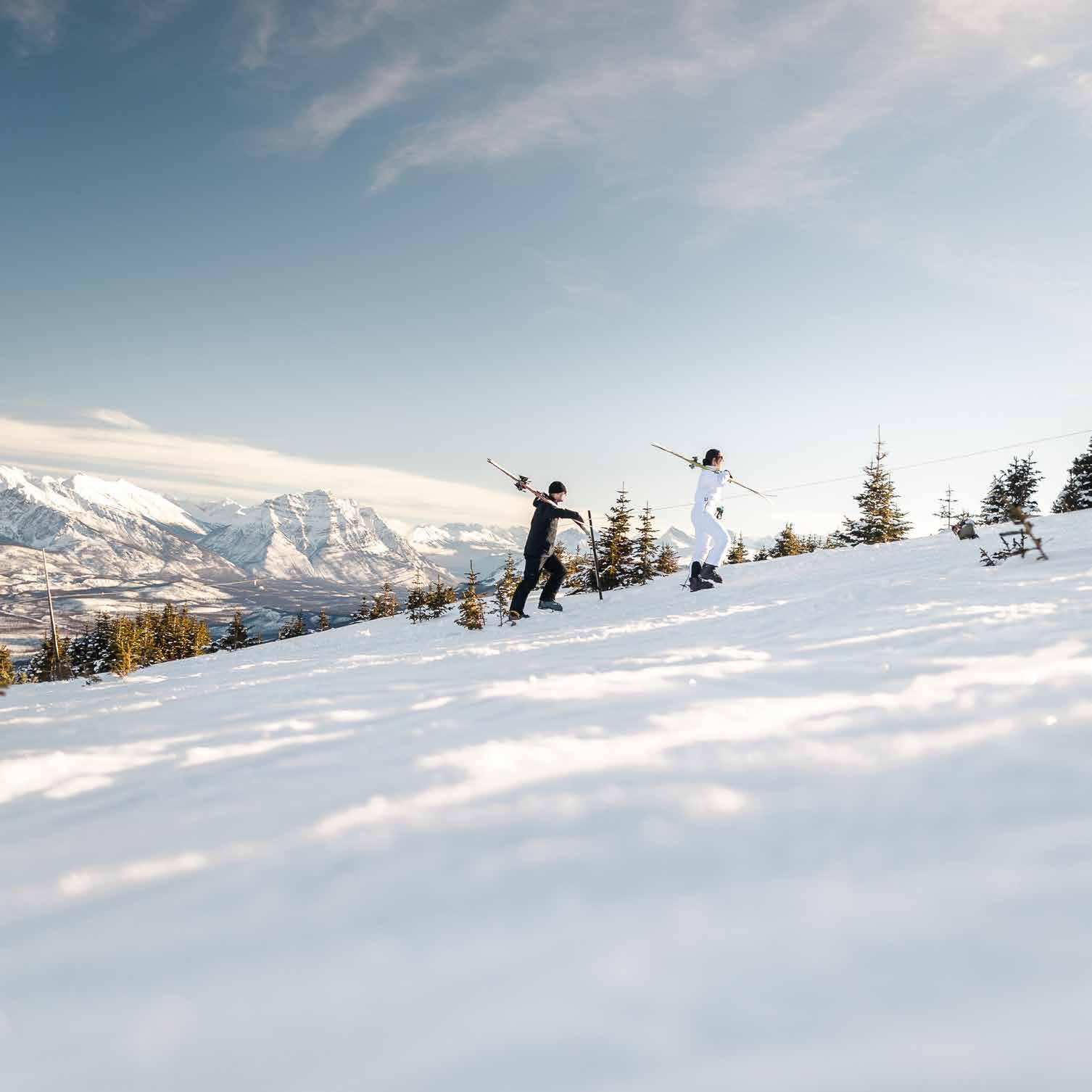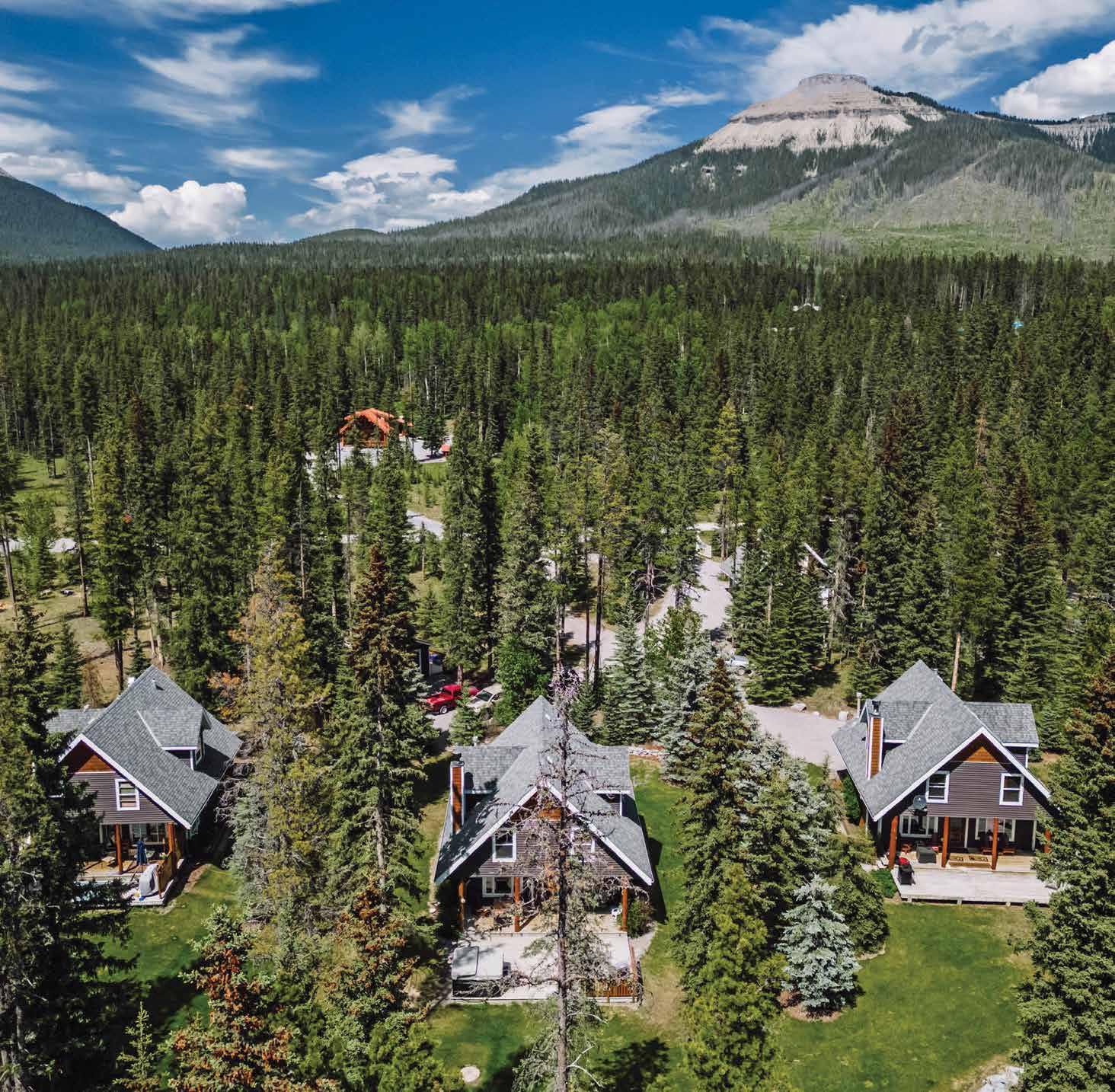
13 minute read
A RADICAL BEAUTY
words :: Bob Covey photos :: Steve Shannon
Loni Klettl’s boots crunch over a blackened pinecone on a popular hiking trail near the Athabasca River. The seed capsule crumbles beneath her sole, its woody scales disintegrating.
Through the blackened trees, an exposed moonscape is carpeted with electric-green grass. Far in the distance, Roche Bonhomme—Old Man Mountain to locals—has the same snowy headdress but a new, charred cape.
Until last summer’s wildfire erased the canopy in this lodgepole forest, Old Man was never visible from this vantage point.
“He’s seen all this before,” Klettl says, taking in the fascinating burn scar, beyond which lie vast patches of pure, even-aged pine forest—evidence of large, intense fires in previous centuries.
Klettl, now 65 years old, was born in Jasper. Her earliest travels on the national park’s extensive trail system were by bassinet. She and her siblings grew up, for parts of their youth, in the backcountry where their warden father was posted; her first steps were in a twobedroom cabin along the park’s North Boundary trail.
Klettl knows Parks Canada trail crew members by name, can describe in detail how most routes evolved, and has some kind of relationship with most every valley bottom approach, subalpine connector and summit scramble in the park—official, unofficial or otherwise.
And as for this particular path— which winds behind Old Fort Point, one of the park’s iconic landmarks and the site of one of the area’s first trading posts—the tread of Klettl’s tires and the soles of her boots have traversed it thousands of times.
But, until recently, it never looked like this.
Massive black root balls, stumps and snappedoff trees tangle together. Leopard-patterned trunks, bark bubbled from radiant heat, form a kaleidoscopic middle ground that stretches into the matte-grey horizon. Aspen stands retain a metres-high singe on the trees’ white bark. And spiral patterns of charcoaled logs give clues to the intensity of the winds that blew through here.
In the middle of the burn zone, some see the blackened forest as hideous—a terrible toll exacted by the July 2024 Jasper Wildfire Complex. Others, like Klettl, see the raw, ravaged and arresting aftermath of the fire as having a spellbinding, surreal beauty. “I can’t stay out of the burn,” she says. “I just find it so fascinating.” visitors are welcome. But Jasper—the park and the town—has changed forever. And it will take years for both to heal.
On July 22, 2024, foreshadowed by record drought conditions, lit by lightning and driven by extreme winds, the Jasper Wildfire Complex raced down the Athabasca River Valley towards the town of Jasper, 30 kilometres away.
In less than two days, the flames burned thousands of meadows, shrublands and forests of all ages and types, culminating in a building, billowing column of heat that collapsed on itself above the slopes of Whistlers Mountain on July 24.

The resulting ember shower hurtled untold numbers of white-hot firebrands— pinecones, sticks and other flaming debris—onto a vulnerable townsite. The wind-driven burning fragments found purchase on cedar shakes, woodpiles and other flammable objects—or entered buildings through gaps— to ignite dozens of structure fires almost simultaneously. This onslaught would have immediately outmatched any conceivable brigade of fire responders, replicating the same tragic pattern repeated in Los Angeles, Lahaina, Lytton and elsewhere.

The devastation—358 structures lost, including the homes of more than 1,800 Jasperites—has been tallied at $1.2 billion in insured losses.
But the numbers are far from the entire story.
Everyone who had a relationship with Jasper National Park will have different journeys of reconciliation with what was lost in the fire, says Jasper Community Team Society executive director and volunteer firefighter Tristan Tomkins.
As such, Tomkins says, it’s too early to celebrate opportunities to build back better, when some residents will never be able to build back at all. It’s insensitive, he feels, to suggest that the fire, which has caused so much heartache, disruption and trauma, has silver linings that people ought to appreciate. And, as long as the community is struggling to find temporary housing for people whose homes were burned, Tomkins says it’s too soon to suggest that a phoenix will somehow rise from the ashes.
It so happens that for many, including Klettl—who, like hundreds of other Jasperites, lost her home and everything in it—the best place to start that healing journey is on the trails.
“That might be for people to discover on their own, but it’s not for anyone else to say,” Tomkins says. “And for some, a phoenix might not ever rise.”
Make no mistake, the rebuild is on, businesses are open and
Near Old Fort Point, where a trail formerly snaked through dense lodgepole pine and Douglas fir forest, a water-washed path now meanders over an exposed valley bottom. Minerals in rock bluffs, once hidden from view, twinkle in the sun (as do broken bottles and exposed bush camps). New spines, plateaus and whaleback ridges draw the wanderer’s eye.
For Klettl—who has wandered more than most in Jasper—the trails have never been more alluring.
“I don’t see doom and gloom when I look around the burn,” she says. “I look up and see uncovered road beds, incredible geology and different ascents.”
While some have been reluctant to visit the burned areas, Klettl has plunged headlong into her work and recreation there. Instead of grieving the scorched forest, she’s celebrating the new landscape, with its myriad new sightlines, access points and alpine opportunities. “Everything is so open. I find it so interesting,” she says.




In the weeks following July 22, 2024, the Jasper Wildfire Complex held the interest of the entire nation. Twelve months of fickle news cycles later, however, some Rockies tourists have no prior knowledge of the fire, the largest in Jasper National Park’s recorded history. “Not all of our guests know we even had a fire,” says Jasper Raft Tours guide Brad Stewart.
The jarring sight of the burn scar, both in the forest and the more confronting scene in the townsite, catches people off guard. The temporary housing on either end of town, the mangled skeletons of incinerated gas pumps and the burned remains of the historic Anglican church—not to mention the ongoing heavy construction amongst entire blocks of levelled lots—is a lot to take in.
“People ask, ‘What happened here?’” Stewart says.
Leaning into his oars, rowing one of the 13 replacement boats his company raised funds for after their fleet was burned, Stewart ponders exactly how he’ll respond to that question this summer. Eventually, he and other frontline staff in Jasper will have a rote answer, and he’s confident the changes to the ecology will help put a fascinating, distracting face on the disaster.
But not everyone will be able to field pointed, personal questions as coolly as relaxed raft guides, small-talk-seasoned bartenders or Jasper’s marketing professionals.
Resident Clara Adriano, who was recently recognized by Jasper municipal council for her behind-the-scenes support of Jasper newcomers and wildfire evacuees, is putting the message out to visitors to please tread lightly when discussing the 2024 wildfire.
“Ask us about the best places to eat, our favourite hike or the must-see places in Jasper. But please try not to ask us about what we lost, if our home is standing or about the losses many are still trying to recover from,” she says. “Not many of us are ready to talk about it yet.”
Back on the river, Jasper’s Christine Nadon is taking a turn at the oars.
When her house burned, she and her partner lost six boats—one canoe, four kayaks and a 16-foot raft, with which they’d often take their friends on lazy evening floats.
“It feels good to get on the water again,” she says. “And from here, the burn doesn’t look nearly as severe as I thought it would.”
Nadon, the Municipality of Jasper’s director of protective and legislative services, has been one of the community’s foremost public-facing officials since the fire. From her post as incident commander—a post she shared with various Parks Canada officers— she distilled and shared critical information about the complex, lifealtering event to media members, visitors and the general public.
But speaking to her fellow residents about the fire is hard for Nadon. Not because she doesn’t have answers, or because she can’t speak to the totality of the response. It’s because reconciling what was lost and what was saved is so damned difficult.
“Every single person who showed up to help us did so to the best of their knowledge and abilities, and I couldn’t be more proud of having been part of that team,” she says to a crowd of residents at a springtime wildfire information session.
Tomkins, who was among the 40 firefighters who made a desperate last stand on July 24 and ultimately saved 70 percent of the town, is more of a straight shooter.
“People ask me if I lost my home,” Tomkins says. “I tell them, ‘No. But I lost a lot of homes.’ That changes the subject pretty quickly.”
It’s not that Tomkins doesn’t want to talk about the fire. Through his work as the chair of the Jasper Volunteer Fire Brigade, the 36-year-old Brit has taken a special interest in helping his colleagues address the very real trauma they experienced. He is helping spearhead the Pathfinders program, an initiative that empowers local leaders with training and tools to assist others navigating recovery.
But reliving and relitigating the cruel, random destruction—how this home was saved but not that one—or attempting to answer impossible questions about impossible choices and situations the emergency crews found themselves in—he’s not going there. It’s still too raw.
“There hasn’t been much time for grieving. That process is still happening, and I think community-wide you can feel that,” he says.
“But is 70 per cent of town saved a success, when you look at the other 30 per cent and all the hardship that it’s caused?” Nadon asks. “It’s kind of hard to bring those things together.”
The fire has done this in Jasper: It’s pulled things apart. It’s pushed people out. It’s left permanent scars. Some residents who built their whole lives here won’t ever be back. Some will rebuild, but others will decide not to—because they have neither the resources, time nor energy to invest in the long road ahead. Many, like 69-year-old Patrick Mooney, whose rented Cabin Creek home was vaporized along with nearly the entire neighbourhood of houses around it, have been floating precariously between temporary accommodations since the community was evacuated last summer.
Following the fire, Mooney spent more than a month in a Grande Prairie reception centre with dozens of other Jasper evacuees. He then moved to a local hotel and, more recently, was given a spot amongst the rows of mobile housing procured by Parks Canada, positioned adjacent to the park’s largest campground. Even though he’s grateful to be housed at all, he says the constant uncertainty has been exhausting.
“I think for many people in Jasper, this fire robbed them of their sense of security, their sense of stability,” Mooney says. “That’s been maybe the hardest part of recovery.”
Mooney is a retired Community Outreach worker. In addictions parlance, a language he’s familiar with, recovery starts with acceptance, self-reflection and amends. Connection and community are important bridges. Finally, reintegration follows restoration and resilience.
But a year after the Jasper Wildfire Complex impinged the town, some residents still don’t accept that the fire was, for all intents and purposes, unstoppable.
Despite the size of the wildfire, its intensity, the 100 km per hour winds it was riding on and the driest conditions recorded since weather stations were installed in the park in the 1960s, there are some who have latched onto misperceptions around the health of the forest and clung to false narratives about the lack of an appropriate, urgent response.
And despite research showing the increased frequency of extreme fires engulfing forests across the planet as a direct symptom of a warming, drying climate, the anti-science pushback against a “climate change narrative,” has become a normal part of the mainstream discourse.
In Jasper, consistent community fireproofing messaging began in the early 2000s with two main champions: Greg Van Tighem, fire chief at the time, as well as Alan Westhaver, Parks Canada’s former long-time fire and vegetation specialist. By the 1990s, managers were well aware that the absence of wildland fire had increased hazards to the town and, between 2003 and 2012, Westhaver oversaw about 1,000 hectares of fuel reduction immediately around the townsite and the neighbouring Fairmont Jasper Park Lodge. From 2014 to 2018, the town and Parks Canada issued many additional contracts to remove beetle-killed trees from those areas, as well as those adjacent to critical infrastructure and evacuation routes. And, beginning in 2018, Parks Canada initiated commercial logging operations in the national park. The mechanical tree harvesting and forest-thinning was renewed in 2025.
Those efforts will never be enough for some, of course. But, shortly after the fire, Mayor Richard Ireland, who lost his home of 67 years in the disaster, rejected entirely any suggestion that there was a failure to prepare for wildfire.
“Everyone got out of town. Most of our town was spared. That could not have happened without the preparatory work done on the landscape,” Ireland says.
Westhaver, who was one of the principal developers of the FireSmart Canada program and continues to work closely with other researchers examining major wildland-urban fire disasters on several continents, is adamant that, while extreme wildfires are inevitable, wildland-urban disasters are not.
Additionally, he says that when extreme wildfires do occur, it’s the conditions within very close range of structures that make the difference between home survival and loss.
“If I had a million dollars, I’d spend 90 per cent of it within 30 metres of homes,” Westhaver says.
He adds that engaging with residents to help them understand and do the little things in their communities, where losses matter most, would make a big difference in preventing disasters such as the Jasper fire.
“We need to redefine this problem—it cannot be solved in the forest,” he says.
To say retired Jasper railroader Lee DeClercq is particular might be an understatement. This is someone who flicks the dirt off his mushrooms in the grocery store to save money.
In that same fastidious fashion, DeClercq has been one of many Jasper residents who for years has taken pains to remove flammable items around his home and make a break in the path of potential ignition. He remembers taking part in multiple neighbourhood fireproofing work bees—denuding trees, tidying up dead branches and removing resin-dense juniper bushes from the areas surrounding the yards.
“I did all kinds of little things to get rid of combustibles once the municipality started making us more aware of the potential of fire,” he says.
Still, of all the homes in Jasper’s now-flattened Cabin Creek neighbourhood, the DeClercq house was the one that many locals agreed, pre-fire, should have been among the most vulnerable.
DeClercq’s lot is the furthest west in all of Jasper. His house sits high atop a hill. And the three-storey structure has cedar cladding not only on the roof (as mandated by Jasper National Park’s tragically misguided, and since updated, Town of Jasper Land Use Policy) but also on its entire exterior—from the foundation to the fascia board.
In the urban wildfire context, DeClercq’s place looks like a matchstick ready to light. Yet his home was one of only five in the devastated Cabin Creek development still standing after the final flames were put out. The keys? Luck, of course—but also DeClercq’s decision to follow basic FireSmart principles.
Additionally, to minimize the flammability of his house, years ago he affixed a rudimentary farm sprinkler atop the roof. During fire season, he turns it on every four days. Westhaver says that DeClercq’s experience is a positive example of what FireSmart collaboration can accomplish.
“What we need is more teamwork between residents and fire responders before the fire," he says. "We already have some great examples of this in Jasper—just not enough.”
Wildfires don’t come into town as a wall of flames, Westhaver says. Instead, the common denominators of communities that burn is that they’re bombarded by burning embers and that properties are vulnerable to ember ignition.
“That’s what people are describing in Jasper,” Westhaver says. “When that huge column collapsed, embers piled up just like snowflakes and ignited combustible objects on or around people’s homes.”

And when multiple structures ignite, fires merge, quickly overwhelming any conceivable response by firefighters, no matter how wellresourced they are.
“We’ve been improving our technology and firefighting capabilities for well over 100 years and yet these events are more frequent than ever,” Westhaver laments.







What would change the game, Westhaver says—more than all the feller bunchers, bulldozers and massive sprinkler systems that any community could round up—is public buy-in to work within the community.
“This is the turnaround that needs to take place,” he says. “But I’m not sure who’s going to take on that leadership role if the fire fraternity doesn’t."
Within the townsite, Jasper will be in recovery mode for years. Demolitions, site clean-ups, soil sampling, remediation, permits, inspections—not to mention the actual construction—all take time. In the surrounding forest, however, the pace of progress is astounding.
David Smith, former fire specialist with Jasper National Park, is confident that, between the aspen clones he’s already spotted coming up and the wildflower super-bloom he knows will pop en masse this summer, many parts of the park will be visually stunning to behold. “In a couple of years, some of these places are going to be unbelievable,” he says.
But it’s not just the fire-affected areas that have experienced a sudden facelift. West of the townsite, on what’s known as the Pyramid Bench, expansive new views have emerged.
The Bench didn ’ t burn in the 2024 wildfire, but it was logged—first in 2018, and again this past winter/spring. The felling is happening in the name of wildfire hazard reduction, and the resulting clearcuts have opened the forest in nearly as dramatic a fashion as that of the fire.
“The new views on the Bench are incredibly amazing,” says trail advocate Loni Klettl.
However, instead of upturned blackened stumps, wind-bent trees and newly unveiled rock gardens, the forest floor here is covered in coarse, woody debris and piles of branches waiting to be burned. Wherever possible, non-fire-prone species, such as aspen and Douglas fir, have been retained. And as for the labyrinth of trails hikers and bikers use to access these corridors of lakes and wetlands, they’re still very much alive.
“The trails all come back,” Klettl says.
Firefighter Tristan Tomkins, like most Rockies residents and visitors, helps release the pressures of his everyday life by spending time outside. He says that, despite the new facades of the community and the park, what ultimately draws people to Jasper can’t be burned: “What makes Jasper, Jasper—community, a sense of welcome and natural beauty—those things might not look exactly the same right now, but they’re all still here.”















